Subspace clothing simulation using adaptive bases
a technology of adaptive bases and subspace clothing, applied in the field of computer animation, can solve the problems of high computational cost, large computational cost, and large wrinkles across the entire front of the sweater
- Summary
- Abstract
- Description
- Claims
- Application Information
AI Technical Summary
Benefits of technology
Problems solved by technology
Method used
Image
Examples
Embodiment Construction
[0024]Realistic computer-generated animations of characters often requires animation of the clothing worn by the animated characters, including animations of wrinkling and stretching as the character moves. Realistic animation of clothing contributes to the style and personality of the animated characters. The methods and systems will be described in relation to the particular example of generating animation of clothing on a character, but it will be apparent to one of skill in the art that the methods and systems may also be applied to other deformable surfaces on an underlying object.
[0025]An overall workflow for producing animation data may include: a data input stage, a training stage, a pose space database (PSDB) and local basis creation stage, and a subspace simulation stage that generates animation data for given poses. In the data input stage, existing information regarding the animation to be performed is received in a computer or computing system. In the training stage, fu...
PUM
 Login to View More
Login to View More Abstract
Description
Claims
Application Information
 Login to View More
Login to View More - R&D
- Intellectual Property
- Life Sciences
- Materials
- Tech Scout
- Unparalleled Data Quality
- Higher Quality Content
- 60% Fewer Hallucinations
Browse by: Latest US Patents, China's latest patents, Technical Efficacy Thesaurus, Application Domain, Technology Topic, Popular Technical Reports.
© 2025 PatSnap. All rights reserved.Legal|Privacy policy|Modern Slavery Act Transparency Statement|Sitemap|About US| Contact US: help@patsnap.com



